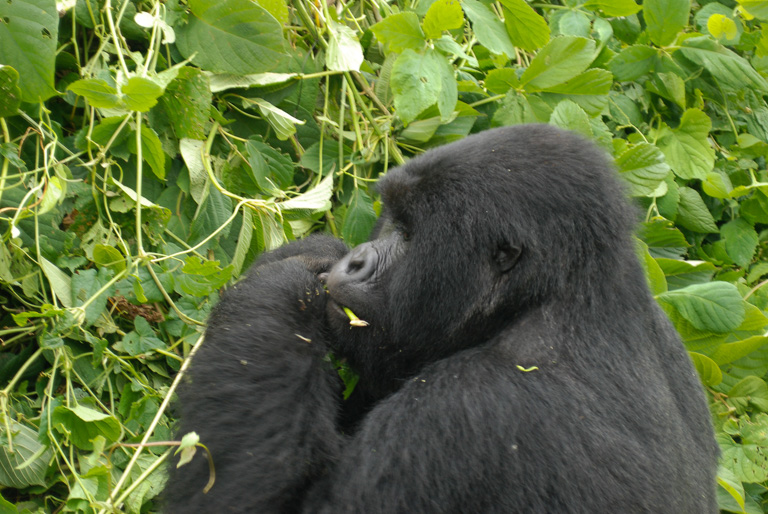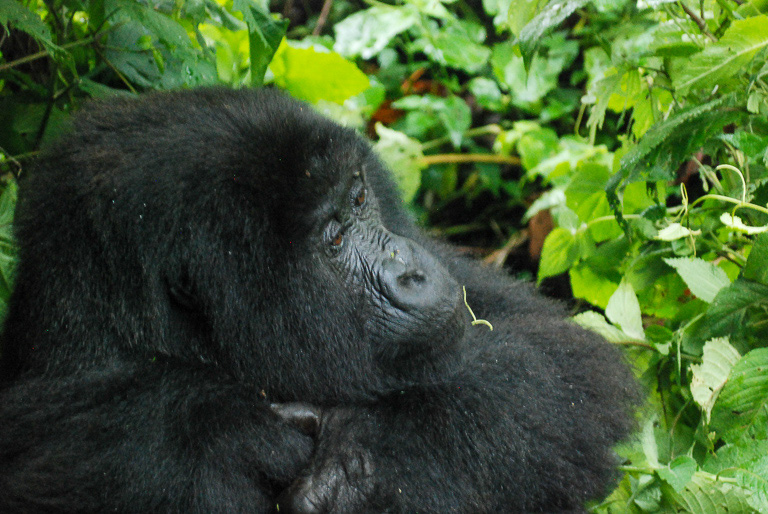- A Mongabay staff writer shares an account of his trek to see mountain gorillas in the Democratic Republic of Congo.
- From a low of 250 individuals in the 1980s, the mountain gorilla subspecies now numbers more than 1,000, making it the only great ape whose population is growing.
- Those gains have come thanks to the “extreme conservation” practiced by a dedicated group of people who have worked to ensure the survival of one of our closest relatives in the animal kingdom.
- This post is insider content, which is available to paying subscribers.
VIRUNGA NATIONAL PARK, Democratic Republic of Congo — Seven meters. It’s one of the first instructions you get from the guides at Virunga National Park, nestled against the eastern border of the Democratic Republic of Congo. Keep that distance, 23 feet, between you and the gorillas when we reach the family group so they don’t feel threatened, they told our party of five people.
What they don’t tell you — and perhaps what should go without saying — is the seven-meter rule applied only to us. No sooner had we heard the “knock-knock-knock” of the chest-beating silverback that I found that fact out firsthand.
“Il ne respecte pas les sept mètres!” Yaya called out as an adolescent male approached me. He doesn’t respect the seven meters!

So, as I’d been instructed, I dropped to one knee, trying to appear as harmless and submissive as possible. I lowered my gaze to avoid eye contact, even though every instinct in me seemed to be saying I should find a way to acknowledge an undeniable link between us.
As we walked around the group of perhaps 15 gorillas, I found I had to suppress the urge to wave in greeting. Their eyes seem to relay a common kinship, perhaps something to do with the 98 percent of our DNA that we have in common going back to a shared ancestor that lived about 10 million years ago.
“You look in their eyes, and somebody’s home, for sure. One hundred percent,” Jan Ramer, a wildlife veterinarian and the then regional manager of Gorilla Doctors, told me at the organization’s headquarters in Musanze on the Rwandan side of the Virunga Mountains.

For me, the trek was both a professional outing and the realization of a childhood dream. The material I gathered would become part of a story I’d eventually write for Slate on the extraordinary challenges facing folks like Ramer who were working to pull the mountain gorilla (Gorilla beringei beringei) back from the edge of extinction.
Groups like the Gorilla Doctors and Virunga’s guards, led by Belgian-prince-turned-park-warden Emmanuel de Merode, have made headway. The mountain gorilla, a subspecies of the eastern gorilla, bottomed out at an estimated 250 individuals in the 1980s. Today there are more than 1,000 sprinkled across the highlands of eastern DRC, western Rwanda and western Uganda. In November 2018, the IUCN announced it was switching the mountain gorillas’ designation from critically endangered to endangered.
“Mountain gorillas are the only great ape population that’s growing,” Ramer said. “The only one.”

Even with these improvements, the vets at Gorilla Doctors follow up on every case of illness or injury they can, knowing that each individual animal figures prominently in the subspecies’ survival.
Likewise, armed guards patrol the park for poachers going after gorillas or other wildlife in the park, considered the most biodiverse in Africa. For decades, the region has been a hotbed of armed conflict, particularly the area around DRC’s Virunga National Park, home to a bloody conflict on the heels of the Rwandan genocide.
All of this insecurity and the resulting poverty in eastern DRC have spawned rampant poaching for meat and the wildlife trade by both locals and soldiers. Ramer’s colleagues showed me a macabre collection of wire and rope snares that they’d cut from the limbs of gorillas.
To this day, an ever-evolving slurry of armed militias battle each other for control in the region. Less than two weeks after my own visit to Virunga, bandits shot de Merode as he was traveling to the park. He eventually recovered, but the attack brought into focus the danger that park guards face every day. Over the last two decades, more than 170 have been killed in Virunga. Their work, and that of de Merode, were the subject of the excellent 2014 documentary Virunga.

Gorillas also face the potential loss of their habitat as a growing human population looks for new places to farm, and tempers can flare when gorillas wander into fields and destroy crops. In yet another contentious issue, locals make charcoal by burning trees in the forest. It serves as fuel for cooking and is one of the few sources of potential income for those living around the park. But it also puts them at odds with authorities under pressure to maintain what’s left of the gorillas’ habitat.
The park is also the site of a years-long battle to prevent oil exploration, potentially with the support of the Congolese government, by foreign companies. Now, too, the violence keeps health care workers from treating people infected with Ebola, prolonging an epidemic that’s been creeping through eastern DRC for more than a year. It’s killed more than 2,000 people, and a spillover of the disease into gorilla populations could be catastrophic.
So far, there haven’t been any reports of cases in gorillas, according to Gorilla Doctors. But veterinarians are on alert after several confirmed cases in humans near gorilla habitat — one in Goma, which sits just south of Virunga, and another in Uganda, about 60 kilometers (37 miles) from Bwindi Impenetrable National Park, home to 430 mountain gorillas at last count in 2011.

In short, the Albertine Rift is not an easy place to do conservation work. Wars have occasionally forced the park to close down. And in May 2018, park managers again shuttered the gates to visitors after two British tourists and their driver were kidnapped. The park reopened again in February 2019, but guards continue to risk their lives to protect the local wildlife.
Luckily, my visit to the gorillas wasn’t so eventful, at least in that way. After a gentle climb through the black-soil potato fields pressed against the boundary of the national park, we crawled under a wire fence and into the national park. From there, the springy mass of tangled vegetation slowed our progress to a crawl. It seemed that no sooner had we hacked our way through the brush than the tangle of vines and lianas would seal off the path behind us. The only instance that raised the alarm of the guards was an unseen forest buffalo crashing through the thicket upslope from our position.
Once we’d found the gorillas, the lead guide then grunted deeply a few times to alert the silverback, and we moved into a clearing where a gorilla sat stripping leaves from a bush, unfazed by our appearance.

Over the next hour, that same blithe indifference to our presence permeated the group. Once, as we were walking on a small path through a copse of broadleaf bushes that sat between two parts of the family, the silverback overtook and brushed past us, knuckle-walking, as if to show us he was aware, but unconcerned, that we were there.
No doubt our visit that day was quickly forgotten by the gorillas. On my end, though, the hour I spent with the gorilla family was quite the opposite. I left that day wondering what the future holds for these animals clinging to existence in the equatorial mountains of eastern Africa. As chaos seems to be closing in around them, they’re still there, thanks in no small part to the dedicated people who are working to protect their remaining habitat, to shield them from bullets and snares, to protect them from disease.

You could write off the gorillas’ success as an anomaly involving a charismatic species only possible with the kind of Herculean “extreme conservation” invested in since the 1980s. Certainly, such an approach won’t save every species that’s in trouble. And expensive efforts aren’t feasible or even possible in every situation. Nor is the gorillas’ survival certain, not by a long stretch.
Even their most prominent advocate, primatologist Dian Fossey, warned they would be extinct by the year 2000. But today, there are four times as many mountain gorillas as there were at the time of Fossey’s death in 1985. Maybe, just maybe, their story might be a ray of hope for what’s possible when scientists and conservationists and the public decide that they won’t abide losing another species to extinction.
Banner image of a young mountain gorilla by John C. Cannon/Mongabay.
John Cannon is a staff writer at Mongabay. Find him on Twitter: @johnccannon
Citation:
Hickey, J.R., Basabose, A., Gilardi, K.V., Greer, D., Nampindo, S., Robbins, M.M. & Stoinski, T.S. (2018). Gorilla beringei ssp. beringei. The IUCN Red List of Threatened Species 2018, e.T39999A17989719. doi:10.2305/IUCN.UK.2018-2.RLTS.T39999A17989719.en
FEEDBACK: Use this form to send a message to the author of this post. If you want to post a public comment, you can do that at the bottom of the page.
